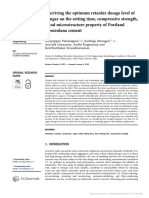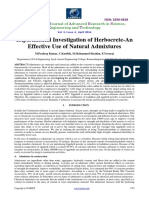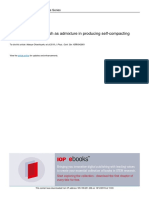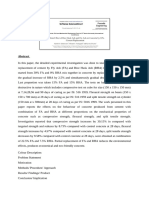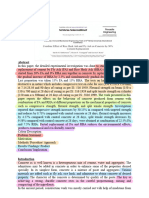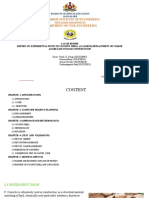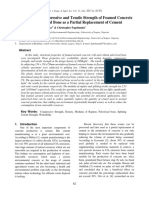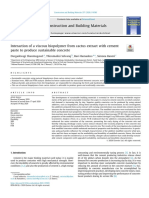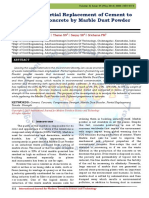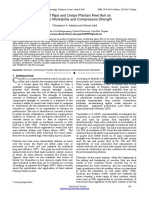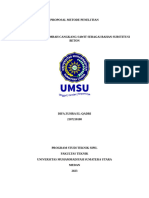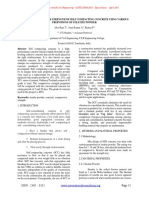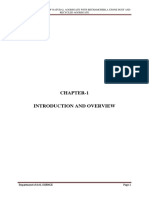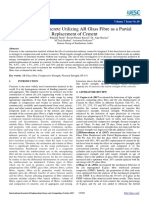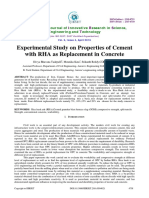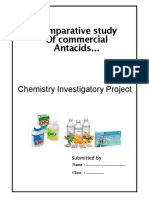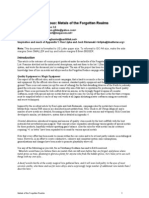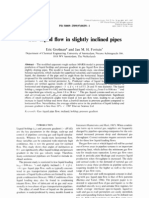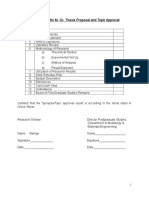Effect of Starch Admixtures On Fresh and Hardened Properties of Concrete
Effect of Starch Admixtures On Fresh and Hardened Properties of Concrete
Uploaded by
Rockstar SantyCopyright:
Available Formats
Effect of Starch Admixtures On Fresh and Hardened Properties of Concrete
Effect of Starch Admixtures On Fresh and Hardened Properties of Concrete
Uploaded by
Rockstar SantyOriginal Title
Copyright
Available Formats
Share this document
Did you find this document useful?
Is this content inappropriate?
Copyright:
Available Formats
Effect of Starch Admixtures On Fresh and Hardened Properties of Concrete
Effect of Starch Admixtures On Fresh and Hardened Properties of Concrete
Uploaded by
Rockstar SantyCopyright:
Available Formats
International Journal of Scientific Engineering and Research (IJSER)
www.ijser.in
ISSN (Online): 2347-3878, Impact Factor (2014): 3.05
Effect of Starch Admixtures on Fresh and Hardened
Properties of Concrete
Shilu Kurian Joseph1, Annie Sonia Xavier2
Post Graduate Student, Department of Civil Engineering, Toc H Institute of Science and Technology, Arakkunnam, Eranakulam, Kerala,
India
Assistant Professor, Department of Civil Engineering, Toc H Institute of Science and Technology, Arakkunnam,Eranakulam, Kerala, India
Abstract: Admixtures are used to alter the properties of concrete. Admixtures are substances introduced into a batch of concrete,
during or immediately before its mixing. There are numerous benefits available through the use of admixtures such as: improved
quality, colouring, greater concrete strength, increased flow for the same water-cement ratio, enhanced frost and sulphate resistance,
improved fire resistance, cracking control, acceleration or retardation in setting time, lower density and improved workability. The
specific effects of an admixture generally vary with the type of cement, mix proportion and dosage. Starch can be used in concrete as
admixture. Starch changes the setting time of concrete. In this particular study, starches used aretapioca and maize.The setting time of
concrete is tested using vicat apparatus. The workability of concrete is tested using slump test. The starch is added for testing with
different percentages of cement. Thesetting timeand workability of concrete/cement increases with the addition of starch
admixtures.Compressive strength, split tensile strength and flexural strength of concrete increases gradually up to an addition of 1.5%
of maize and 2% of tapioca. Further increase in the addition of starch admixtures reduces the compressive strength, split tensile
strength and flexural strength.The starch admixtures such as maize and tapioca can replace the use of chemical admixtures. It also
reduces the additional cost of using chemical admixtuers.
Keywords: Admixtures; Setting time; Workability; Starches; Concrete
1. Introduction purposes such as a thickener / stabilizer and gelling agent. It
is used in the construction industry as gypsum board binder,
Concrete is considered as a very strong and versatile asbestos, clay and limestone binder, fire-resistant wallboard,
mouldable construction material. Its composition is cement, plywood / chipboard adhesive, cement block binder and
fineaggregate and coarse aggregate mixed with water. The paint filler.Starch can also be used as admixtures in
cement and water coats the fine and coarse aggregate in the concrete.Starches such as tapioca and maize increase the
form of a paste or gel. The cement, which is chemically setting time and workability of concrete. The maize and
reacted with water hardens and binds the whole mix together. tapioca are abundantly available. The cost of starch
The initial hardening reaction occurs within a few hours. To admixturesis lower than that of chemical and mineral
achieve full hardness and strength, the concrete takes some admixtures.
weeks. Concrete continues to harden and gain strength over
many years. Substances added to concrete mixes to modify The tapioca and maize are agricultural products. The use of
one or more properties of the concrete to make them suitable them as a replacement for chemical admixtures in concrete is
for some specific purposes are known as admixtures. an eco- friendly concept. Use of tapioca and maize reduce
Normally, admixtures are used to modify a single property. the additional cost of using chemical admixtures.Starch
But some of the admixtures are able to modify more than one admixtures such as tapioca and maize increase the setting
properties of the concrete or grout mix. An admixture for a time of concrete/cement.
special purpose can also be introduced in a mix.
1.1 Literature Review
Admixtures are classified into several categories according
to the purposes of their use. Some common categories are 1.2 A. A. Akindahunsi, et al. (2015)[1]analysed
accelerating admixtures,water reducing admixtures, retarding concrete cubes containing different percentages of the
admixtures, air entraining admixtures etc. Admixtures can be cassava and maize by weight of cement (0, 0.5, 1.0, 1.5 and
classified by function as follows: air-entraining admixtures, 2.0 %). Crushed granite is used as coarse and fine
accelerating admixtures, hydration-control, corrosion aggregates. The maximum coarse aggregate size used is 22
inhibitors, shrinkage reducers, retarding admixtures, water- mm. Starches used in this investigation generally delay the
reducing admixtures, colouringadmixtures, plasticizers, setting time of cement. It was an advantage foruse where a
alkali-silica reactivity inhibitors, and miscellaneous longer period of time is required for castingthe concrete.
admixturessuch as workability andbonding admixtures, Cassava starch will lead to less slump and higher viscosity in
foaming,grouting, dampproofing and permeability reducing concretes when compared to maize starch. The durability
admixtures, gas-forming, anti-washout and pumping properties of the concrete were improved by the addition of
admixtures. Chemical, mineral and starch admixtures are cassava and maize starches.Abalaka, A. E. (2011)[2]studied
also used in concrete. the comparative effects of cassava starch and simple
laboratory quality sugar on concrete. Simple white sugar was
Admixtures are those ingredients added in concrete mixture used at concentrations of 0 to 1% by weight of cement and
immediately to alter the properties of concrete in addition to wascured at 3, 7, 14 and 28 days using ordinary Portland
cement, water and aggregates.Starch is used for different cement. Cassava starch was used at the concentrations of 0 to
1% by weight of cement in concrete. Maximum compressive
Volume 4 Issue 3, March 2016
Paper ID: IJSER15705 27 of 30
Licensed Under Creative Commons Attribution CC BY
International Journal of Scientific Engineering and Research (IJSER)
www.ijser.in
ISSN (Online): 2347-3878, Impact Factor (2014): 3.05
strength recorded for cassava starch at 28 days occurred at maintain a given slump and set more quickly. Cassava
0.05% concentration with a slightly reduced initial setting powder is a low cost admixture to increase the workability
time. The maximum compressive strength increase for sugar andretard the setting time of concrete. Laboratory results
at 28 days occurred at 0.06% concentration with an increase showed that the use of cassava powder as a retarder has
in initial setting time. Within the range of cassava starch thepotential of retarding setting time, increasing workability
concentration presented in this work, it could serve as a good and increasing both the long and early term strength of the
substitute for sugar as an admixture in concrete.F. O. concrete. Its use is a simple and economically preferred
Okafor (2008)[3] investigated the potentials of cassava flour solution to its environmental problem.
as a set-retarding admixture in concrete. The properties
tested include workability and setting time of the fresh 2. Experimental Investigation
concrete and compressive strength of the hardened concrete.
Cassava flour delayed the setting time of cement up to 6 2.1 Materials used
hours at dosage level not exceeding 3% by weight of
cement.The observed increase in the relative compressive Cement used is Dalmia cement OPC with53 grade
strength is of the order of 11% at 3% dosage level of the confirming to specifications as per IS: 12269-1987[8].Specific
admixture. Enhanced workability, compaction and higher gravity of cement is found out as 3.15as per IS 4031 Part: 11
density are achieved by the use of cassava flour as admixture -1988[9]. Standard consistency is found out as 31 % as perIS
in concrete.On the basis of this investigation, it would appear 4031 Part: 4 -1988[10] and initial setting time is found out as
that cassava flour perform satisfactorily as a set-retarding 40 minutes as per IS 4031 Part: 5 -1988[11]. The fine
admixture in concrete.Giridhar V., et al. (2013)[4] focused aggregate used is M sand with specific gravity 2.65. The
on the effect of Sugar and Jaggery on strength properties of coarse aggregate used is crushed granite stone of maximum
concrete. Experiments were carried out for evaluating the size 20 mm with specific gravity 2.70. Tapiocaand maize
strength properties of concrete using Sugar and Jaggery as starches used are first dried and then crushed into powder
admixtures. The main function for usage of Sugar and form. The maximum size of starches used are 10 micro
Jaggery is to extend the initial setting time of concrete. Three meter.
different percentages of admixtures were chosen in the
experimentation as 0, 0.05 and 0.1% by weight of cement.
Workability and compressive strength were increased when
the dosage of admixtures were increased. Segregation and
bleeding was very less due to the usage of these
admixtures.J.J. Brooks, et al. (2000)[5] studied the effect of
fly ash, silica fume, metakaolin, and ground granulated blast
furnace slag on the setting times of high-strength concrete
had been investigated using the penetration resistance
method. Whenpart of the cement is replaced by mineral
admixtures, the setting times of the high-strength concrete is
retarded. While the shrinkage-reducing admixture was found
to have negligible effect on the setting times of normal
strength concrete, a significant retarding effect is shown by it
when used in combination with superplasticiser in high-
strength concrete. The inclusion of granulated blast furnace
slag at replacement levels of 40% and greater resulted in
significant retardation in setting times. When replacement
levels of the mineral admixtures were increased, it was found
that there was a greater retardation in setting times. Olekwu Figure 1: SEM imagesof tapioca powder
B. E., et al. (2014)[6] focused on the use of cassava starch as
an additive in burnt earth bricks. Cassava is available in most
part of the country. Hence the possibility of using cassava
starch as an additivefor producing burnt earth bricks is of
great importance to enhance their physical property, such as
compressive strength, water absorption and abrasion
resistance. Cassava starch content of 0%, 4%, 6%, 10% and
12% were used in the mix. The result from the research
showed that water absorption of burnt earth bricks was
reduced considerably with the addition of cassava starch in
the mix. At an optimum amount of 6% of cassava starch
content, satisfactory performance of the earth burnt bricks
was achieved and is thus recommended for incorporation as
an additive in producing earth burnt bricks.George R. O.
(2014)[7] presented possible implementation of hot weather
concreting practices using cassava powder admixtures that
eliminate or minimize fresh and hardened concrete problems.
From literature, it is found that hot weather increases the
temperature of fresh concrete demandingmore water to Figure 2: SEM images of maize powder
Volume 4 Issue 3, March 2016
Paper ID: IJSER15705 28 of 30
Licensed Under Creative Commons Attribution CC BY
International Journal of Scientific Engineering and Research (IJSER)
www.ijser.in
ISSN (Online): 2347-3878, Impact Factor (2014): 3.05
2.2. Test for Setting Time Table 3: Compressive strength of concrete with starch
admixtures
The cement paste with different percentage addition of starch Different percentages of starch Compressive
admixtures is prepared and the initial setting time is found admixtures Strength (N/mm2)
out using Vicat apparatus. The addition of maize is fixed as Control Concrete 36.635
1.5% of cement and the addition of tapioca is varying (0.5%, 0.5 % tapioca and 1.5%maize 37.681
1.0%, 1.5%, 2%and 2.5%). These are added to the cement in 1.0 % tapioca and 1.5%maize 38.565
1.5 % tapioca and 1.5%maize 39.781
combination of two starches.
2.0 % tapioca and 1.5%maize 40.515
2.5 % tapioca and 1.5%maize 38.832
2.3. Test on Workability of Concrete
The split tensile strength of concrete added with different
The concrete with different percentage addition of starch combination of starch admixtures are tabulated as below.
admixtures is prepared and the workability of concrete is
found out using slump test. Table 4: Split tensile strength of concrete with starch
admixtures
2.4. Test on Compressive Strength of Concrete Different percentages of starch Split Tensile
admixtures Strength (N/mm2)
The compressive strength of concrete with different Control Concrete 3.158
percentage addition of starch admixtures is found out using 0.5 % tapioca and 1.5%maize 3.281
compression testing machine. 1.0 % tapioca and 1.5%maize 3.496
1.5 % tapioca and 1.5%maize 3.658
2.5. Test on Split Tensile Strength of Concrete 2.0 % tapioca and 1.5%maize 3.862
2.5 % tapioca and 1.5%maize 3.524
The split tensile strength of concrete with different
percentage addition of starch admixtures is also found out. The Flexural strength of concrete added with different
combination of starch admixtures are tabulated as follows.
2.6. Test on flexural Strength of Concrete Table 5: Flexural Strength of concrete with starch
admixtures
The flexural strength of concrete with different percentage Different percentages of starch Flexural Strength
addition of starch admixtures is found out using universal admixtures (N/mm2)
testing machine. Control Concrete 5.08
0.5 % tapioca and 1.5%maize 5.29
3. Results 1.0 % tapioca and 1.5%maize 5.47
1.5 % tapioca and 1.5%maize 5.68
2.0 % tapioca and 1.5%maize 5.83
The initial setting time of cement added with different 2.5 % tapioca and 1.5%maize 5.70
combination of starch admixtures are tabulated follows.
Table 1: Initial setting time of cement with starch 4. Conclusion
admixtures
Different percentages of starch Initial setting From the study carried out, it is found that the setting time
admixtures time ( minutes) and workability of concrete are increased by the addition of
0.5 % tapioca and 1.5%maize 130 starch admixtures namely tapioca and maize. So whenever a
1.0 % tapioca and 1.5%maize 136
delay in placing of concrete is necessary, we can use these
1.5 % tapioca and 1.5%maize 145
2.0 % tapioca and 1.5%maize 156
admixtures. The compressive strength, split tensile strength
2.5 % tapioca and 1.5%maize 160 and flexural strength of concrete increase up to an addition of
maize 1.5 % and tapioca 2% and further addition of maize
The workability of concrete added with different and starch reduce the compressive strength, split tensile and
combination of starch admixtures are tabulated below. flexural strength.Since tapioca and maize are locally
available and are cheaper than chemical admixtures, we can
Table 2: Workability of concrete with starch admixtures replace chemical admixtures by these starch admixtures.
Different percentages of starch
Slump(mm)
admixtures References
Control Concrete 100
0.5 % tapioca and 1.5%maize 102 [1] A. A. Akindahunsi and H.C. Uzoegbo, "Strength and
1.0 % tapioca and 1.5%maize 106 durability properties of concrete with starch
1.5 % tapioca and 1.5%maize 111 admixture",International Journal of Concrete
2.0 % tapioca and 1.5%maize 116
Structuresand Materials, July 2015.
2.5 % tapioca and 1.5%maize 121
[2] Abalaka A. E., “ Comparative effects of cassava starch
and simple sugar in cement mortar and concrete”,ATBU
The 28 day compressive strength of concrete added with
Journal of Environmental Technology, Volume No 4,
different combination of starch admixtures are tabulated as
Issue NO. 1, PP. 13-22, 2011.
follows.
[3] F. O. Okafor, “The potentials of cassava flour as a set-
retarding admixture in concrete”, Nigerian Journal of
Technology, Volume No. 27, Issue No.1, PP. 5-11,2008.
Volume 4 Issue 3, March 2016
Paper ID: IJSER15705 29 of 30
Licensed Under Creative Commons Attribution CC BY
International Journal of Scientific Engineering and Research (IJSER)
www.ijser.in
ISSN (Online): 2347-3878, Impact Factor (2014): 3.05
[4] GiridharV,Gnaneswar K, Kishore Kumar Reddy
P,"Effect of sugar and jaggery on strength properties of
concrete",The international Journal of Engineering and
Science, Volume No. 2, Issue No.10, PP. 1-6, 2013.
[5] J.J. Brooks, M. A.MegatJohari, M.Mazloom, “ Effect of
admixtures on the setting times of high-strength
concrete”,Cement& Concrete Composites, Volume No.
22, PP. 293-301, 2000.
[6] Olekwu Benjamin Elah and Aliyu D, “ The use of
cassava starch in earth burnt bricks”, International
Journal of Engineering and Technology, Volume No.
27, Issue No.1, PP. 5-11, 2014.
[7] George Rowland Otoko, "Minimising hot weather
effects on fresh and hardened concrete by use of cassava
powder as admixture", European International Journal
of Science and Technology, Volume No. 3, Issue No. 2,
PP. 1-8, 2014.
[8] IS 12269-1987. Specification for 53 grade ordinary
portland cement. New Delhi (India): Bureau of Indian
Standards.
[9] IS 4031 Part: 11 -
1988.MethodsofphysicaltestsforHydraulic cement, Part
11: Determination of density. New Delhi (India): Bureau
of Indian Standards.
[10] IS 4031 Part: 4 -1988. Methods of physical tests for
Hydraulic cement, Part 4: Determination of consistency
of standard cement paste. New Delhi (India): Bureau of
Indian Standards.
[11] IS 4031 Part: 5 -1988. Methods of physical tests for
Hydraulic cement, Part 5: Determination of initial and
final setting times. New Delhi (India): Bureau of Indian
Standards.
Volume 4 Issue 3, March 2016
Paper ID: IJSER15705 30 of 30
Licensed Under Creative Commons Attribution CC BY
You might also like
- 2nd Quarter FINAL EXAM General Biology 1Document2 pages2nd Quarter FINAL EXAM General Biology 1Cherrina Aguila78% (9)
- Pure Culture Isolation and Biochemical TestingDocument77 pagesPure Culture Isolation and Biochemical TestingReborn ParedesNo ratings yet
- Corn Starch PDFDocument12 pagesCorn Starch PDFMostafa Hussein AbdouNo ratings yet
- Project Report Final12345Document37 pagesProject Report Final123459px97np56mNo ratings yet
- 1848-Article-10 1556-1848 2024 00753Document9 pages1848-Article-10 1556-1848 2024 00753bakatono13No ratings yet
- A Comparative Study On The Effect of Different Types ChemicalDocument6 pagesA Comparative Study On The Effect of Different Types ChemicalSajjad HossainNo ratings yet
- 6 IJARSET PradeepkumarDocument6 pages6 IJARSET PradeepkumarMani KandanNo ratings yet
- An Experimental Study in Using Natural Admixtures As-1Document61 pagesAn Experimental Study in Using Natural Admixtures As-1Lansom GreenNo ratings yet
- The Use of Rice Husk Ash As Admixture in ProducingDocument8 pagesThe Use of Rice Husk Ash As Admixture in ProducingDEINA GERAUDY BARON ATUESTANo ratings yet
- Experimental Study On Blended Concrete in R.C.C Beam and Its Behaviour Phase-Ii Review-1Document17 pagesExperimental Study On Blended Concrete in R.C.C Beam and Its Behaviour Phase-Ii Review-1HemapriyaNo ratings yet
- Ijsrdv3i110384 PDFDocument5 pagesIjsrdv3i110384 PDFtonydisojaNo ratings yet
- Ijsrdv3i110384 PDFDocument5 pagesIjsrdv3i110384 PDFtonydisojaNo ratings yet
- Brijesh ERL PDFDocument5 pagesBrijesh ERL PDFBrajeshNo ratings yet
- A Study On Strength and Durability Characteristics of Concrete With Partial Replacement of Fine Aggregate by Laterite SandDocument8 pagesA Study On Strength and Durability Characteristics of Concrete With Partial Replacement of Fine Aggregate by Laterite SandIJIRSTNo ratings yet
- IJTSEV2I504Document3 pagesIJTSEV2I504Alamgir kabirNo ratings yet
- AbstractDocument2 pagesAbstractnrlshafiqah.shaaNo ratings yet
- Activity Week 3 Ecc563 NurulDocument2 pagesActivity Week 3 Ecc563 Nurulnrlshafiqah.shaaNo ratings yet
- K.H.Kabbur Institute of EngineeringDocument32 pagesK.H.Kabbur Institute of EngineeringTanushNo ratings yet
- Flow Behavior and Strength For y Ash Blended Cement Paste and MortarDocument8 pagesFlow Behavior and Strength For y Ash Blended Cement Paste and MortarZuhair NadeemNo ratings yet
- Experimental Study of Partial Replacement of Cement in Concrete With Marble Dust and Recron Fibre As AdmixtureDocument9 pagesExperimental Study of Partial Replacement of Cement in Concrete With Marble Dust and Recron Fibre As AdmixtureEditor IJTSRDNo ratings yet
- 120 385 1 PB PDFDocument12 pages120 385 1 PB PDFHanz BautistaNo ratings yet
- Improving Mortar Properties in Saline Environment: November 2016Document5 pagesImproving Mortar Properties in Saline Environment: November 2016Arbi811No ratings yet
- Interaction of A Viscous Biopolymer From Cactus Extract With Cement Paste To Produce Sustainable ConcreteDocument8 pagesInteraction of A Viscous Biopolymer From Cactus Extract With Cement Paste To Produce Sustainable ConcreteTuğçe VuralNo ratings yet
- Construction and Building Materials: Durgadevagi Shanmugavel, Thirumalini Selvaraj, Ravi Ramadoss, Simona RaneriDocument8 pagesConstruction and Building Materials: Durgadevagi Shanmugavel, Thirumalini Selvaraj, Ravi Ramadoss, Simona Ranerividal3213No ratings yet
- Marble Powder For Normal Concrete M20 PDFDocument12 pagesMarble Powder For Normal Concrete M20 PDFgururajNo ratings yet
- Effect of Ripe and Unripe Plantain Peel Ash On Concrete Compressive StrengthDocument4 pagesEffect of Ripe and Unripe Plantain Peel Ash On Concrete Compressive StrengthOluwaseun AdetayoNo ratings yet
- Experimental Study On Partial Replacement of Cement by Banana Leaves AshDocument8 pagesExperimental Study On Partial Replacement of Cement by Banana Leaves AshphenomNo ratings yet
- Performance Evaluation of Sugarcane BagaDocument12 pagesPerformance Evaluation of Sugarcane BagaPriyesh KolteNo ratings yet
- Major Project JournalDocument8 pagesMajor Project Journalalwinr89No ratings yet
- Synergistic Effect of Latex Powder and Rubber On TDocument10 pagesSynergistic Effect of Latex Powder and Rubber On TMuhammad ImranNo ratings yet
- 2016 Experimental Analysis of Strength and Durability Properties of Quaternary Cement Binder and MortarDocument8 pages2016 Experimental Analysis of Strength and Durability Properties of Quaternary Cement Binder and MortarTiago BragaNo ratings yet
- Proposal Metode Penelitian - Difa Zuhra El-QadriDocument15 pagesProposal Metode Penelitian - Difa Zuhra El-QadriLusia JuwitaNo ratings yet
- Study On Compressive Strength of Self Compacting Concrete Using Various Propotions of Steatite PowderDocument5 pagesStudy On Compressive Strength of Self Compacting Concrete Using Various Propotions of Steatite PowderBharath BharathNo ratings yet
- With ReadingsDocument44 pagesWith ReadingsGaurav JethleNo ratings yet
- Chapter-1 1.1.1 GENERALDocument45 pagesChapter-1 1.1.1 GENERALVishNo ratings yet
- Tile Adhesive Production by Inorganic Materials: Fasil Alemayehu Hayilu and Omprakash SahuDocument5 pagesTile Adhesive Production by Inorganic Materials: Fasil Alemayehu Hayilu and Omprakash SahuMed Hédi BANNANINo ratings yet
- Jurnal SkripsiDocument6 pagesJurnal SkripsiKokoh Tiodito PamungkasNo ratings yet
- Adm Compatible Marsh ConeDocument5 pagesAdm Compatible Marsh ConeTin NguyenNo ratings yet
- Conference Paper. Final - AnkieDocument5 pagesConference Paper. Final - AnkieAnkieNo ratings yet
- An Experimental Study On Portland Pozzolana CementDocument6 pagesAn Experimental Study On Portland Pozzolana Cement王志培No ratings yet
- Article Text 463742 1 10 20190116 2Document7 pagesArticle Text 463742 1 10 20190116 2Jiu ShitzukiNo ratings yet
- Replacement of Coconut Shell and ResultsDocument69 pagesReplacement of Coconut Shell and ResultsganapathyNo ratings yet
- Construction and Building Materials: Turhan Bilir, Osman Gencel, Ilker Bekir TopcuDocument8 pagesConstruction and Building Materials: Turhan Bilir, Osman Gencel, Ilker Bekir TopcukanomasiNo ratings yet
- DMT Int Journal July 2008 10Document7 pagesDMT Int Journal July 2008 10Bajrang GuptaNo ratings yet
- 45 - Foundry Sand Utilisation As A Partial Replacement of Fine Aggregate For Establishing Sustainable Concrete PDFDocument4 pages45 - Foundry Sand Utilisation As A Partial Replacement of Fine Aggregate For Establishing Sustainable Concrete PDFArunkumar AKNo ratings yet
- Chapter-1: Partial Replacement of Natural Aggregate With Bethamcherla Stone Dust and Recycled AggregateDocument66 pagesChapter-1: Partial Replacement of Natural Aggregate With Bethamcherla Stone Dust and Recycled AggregatepatanelakathNo ratings yet
- Comptibility by Maesh Cone-1Document5 pagesComptibility by Maesh Cone-1Rajesh KumarNo ratings yet
- Behaviour of Concrete Utilizing AR Glass Fibre As A Partial Replacement of CementDocument5 pagesBehaviour of Concrete Utilizing AR Glass Fibre As A Partial Replacement of CementdarshanNo ratings yet
- Glass Powder PropertiesDocument7 pagesGlass Powder PropertiesMR. ESHAN GHARPURENo ratings yet
- Partial Replacement of Fine Aggregate AnDocument5 pagesPartial Replacement of Fine Aggregate Analwinr89No ratings yet
- Partial Replacement of River Sand With Quarry Rock DustDocument8 pagesPartial Replacement of River Sand With Quarry Rock DustDharma banothuNo ratings yet
- Effect of High Dosage Air-Entraining Admixture Usage On Micro Concrete PropertiesDocument12 pagesEffect of High Dosage Air-Entraining Admixture Usage On Micro Concrete PropertiesRizeruNo ratings yet
- Banana Fibre Reinforced Concrete 1Document18 pagesBanana Fibre Reinforced Concrete 1ved100% (1)
- 1 s2.0 S223878542100418X MainDocument9 pages1 s2.0 S223878542100418X Mainanunciano GuterresNo ratings yet
- Construction and Building Materials: Gurpreet Singh, Rafat SiddiqueDocument6 pagesConstruction and Building Materials: Gurpreet Singh, Rafat SiddiqueharshitNo ratings yet
- Characteristics of Foam Concrete With Usage of Foam Agent Which Varies Review On Density Strength and Water AbsorptionDocument4 pagesCharacteristics of Foam Concrete With Usage of Foam Agent Which Varies Review On Density Strength and Water AbsorptionReshmita PallaNo ratings yet
- Partial Replacement of Fine Aggregate by Marble PowderDocument3 pagesPartial Replacement of Fine Aggregate by Marble PowderNihal SinghNo ratings yet
- Experimental Study On Properties of Cement With RHA As Replacement in ConcreteDocument6 pagesExperimental Study On Properties of Cement With RHA As Replacement in ConcreteDivya TadepalliNo ratings yet
- ZA051105162166Document5 pagesZA051105162166Nihal SinghNo ratings yet
- Construction and Building Materials: Mehmet Gesog Lu, Erhan Güneyisi, Erdog An ÖzbayDocument8 pagesConstruction and Building Materials: Mehmet Gesog Lu, Erhan Güneyisi, Erdog An ÖzbaySeema p kumarNo ratings yet
- Experimental Investigation of Waste Glass Powder As Partial ReplaDocument7 pagesExperimental Investigation of Waste Glass Powder As Partial ReplaGhislainNo ratings yet
- PRACTICE TO PERFECT A CHEM SK015 (SET 1) SoalanDocument4 pagesPRACTICE TO PERFECT A CHEM SK015 (SET 1) SoalanaNo ratings yet
- Chapter 6 Stabilized Pavement MaterialsDocument16 pagesChapter 6 Stabilized Pavement Materialsዳጊ ዳጊ ዳጊNo ratings yet
- Tin Bronze C90300 PDFDocument1 pageTin Bronze C90300 PDFDeepak KumarNo ratings yet
- Wire Rs For LNG ElseDocument2 pagesWire Rs For LNG ElserajabalaNo ratings yet
- Antioxidant and Antiproliferative Activity of Hypericum Hircinum L. Subsp. Majus (Aiton) N. Robson Essential OilDocument9 pagesAntioxidant and Antiproliferative Activity of Hypericum Hircinum L. Subsp. Majus (Aiton) N. Robson Essential Oilgaurav saxenaNo ratings yet
- Griffith ElmagDocument6 pagesGriffith ElmagnadiaNo ratings yet
- Giant Tube WormsDocument7 pagesGiant Tube WormsChipotle ObsessedNo ratings yet
- Surface Chemistry-1Document29 pagesSurface Chemistry-1rajbioNo ratings yet
- ProjectDocument12 pagesProjectD E V I LNo ratings yet
- Metals Most Marvellous - Metals of The Forgotten RealmsDocument52 pagesMetals Most Marvellous - Metals of The Forgotten RealmsGnomeMadeIon100% (5)
- O IntegratedscienceDocument36 pagesO IntegratedscienceFarai FaustosNo ratings yet
- Animal Health: Adjustment of Rheological Properties For Veterinary SuspensionsDocument2 pagesAnimal Health: Adjustment of Rheological Properties For Veterinary SuspensionssalemNo ratings yet
- Physical Sciences Lesson 3 The Atomic Structure and The Chemical ElementsDocument16 pagesPhysical Sciences Lesson 3 The Atomic Structure and The Chemical ElementsJustin BirdNo ratings yet
- Black Liquor Dry Matter Content and Fibre Content n22-96Document7 pagesBlack Liquor Dry Matter Content and Fibre Content n22-96PeaceNo ratings yet
- Electrostatic PrecipitatorDocument76 pagesElectrostatic Precipitatorerskd100% (2)
- Unit 2 Atomic StructureDocument43 pagesUnit 2 Atomic StructureSalam KhalafNo ratings yet
- Gas-Liquid Flow in Slightly Inclined PipesDocument11 pagesGas-Liquid Flow in Slightly Inclined PipesBrenda DavisNo ratings yet
- RheologyDocument54 pagesRheologyShivraj JadhavNo ratings yet
- Falk Series C, E, F, G, J, P, Q, S, Y Gear Drives - Service ManualDocument4 pagesFalk Series C, E, F, G, J, P, Q, S, Y Gear Drives - Service ManualJorge Iván Carbajal100% (1)
- Thermodynamics Group AssignmentDocument14 pagesThermodynamics Group AssignmentCecilia BarantandaNo ratings yet
- Proposal Ready 4 (Dr. Aneela Wakeel) RevisedDocument15 pagesProposal Ready 4 (Dr. Aneela Wakeel) RevisedIrfanButtNo ratings yet
- Overview of Alkene ReactionsDocument11 pagesOverview of Alkene ReactionsVickyNo ratings yet
- 3 Pureballast 3.2/ Pureballast 3.2 Compact Flex 3Document11 pages3 Pureballast 3.2/ Pureballast 3.2 Compact Flex 3TamNo ratings yet
- Chemistry IVP OriginalDocument15 pagesChemistry IVP OriginalPurushoth V SNo ratings yet
- Computational Chemistry: An Introduction To Molecular Dynamic SimulationsDocument23 pagesComputational Chemistry: An Introduction To Molecular Dynamic Simulationsrajesh.v.v.kNo ratings yet
- MCQ in Power Plant Engineering Part 2 - ME Board ExamDocument23 pagesMCQ in Power Plant Engineering Part 2 - ME Board ExamRobert V. AbrasaldoNo ratings yet
- Nomenclature of LipidsDocument11 pagesNomenclature of LipidsJaella ANo ratings yet
- Example 3p10 Incropera 6th Edition 2007Document3 pagesExample 3p10 Incropera 6th Edition 2007minhazul islamNo ratings yet




